Shusheng Yang
Towards Ambiguity-Free Spatial Foundation Model: Rethinking and Decoupling Depth Ambiguity
Mar 08, 2025Abstract:Depth ambiguity is a fundamental challenge in spatial scene understanding, especially in transparent scenes where single-depth estimates fail to capture full 3D structure. Existing models, limited to deterministic predictions, overlook real-world multi-layer depth. To address this, we introduce a paradigm shift from single-prediction to multi-hypothesis spatial foundation models. We first present \texttt{MD-3k}, a benchmark exposing depth biases in expert and foundational models through multi-layer spatial relationship labels and new metrics. To resolve depth ambiguity, we propose Laplacian Visual Prompting (LVP), a training-free spectral prompting technique that extracts hidden depth from pre-trained models via Laplacian-transformed RGB inputs. By integrating LVP-inferred depth with standard RGB-based estimates, our approach elicits multi-layer depth without model retraining. Extensive experiments validate the effectiveness of LVP in zero-shot multi-layer depth estimation, unlocking more robust and comprehensive geometry-conditioned visual generation, 3D-grounded spatial reasoning, and temporally consistent video-level depth inference. Our benchmark and code will be available at https://github.com/Xiaohao-Xu/Ambiguity-in-Space.
Thinking in Space: How Multimodal Large Language Models See, Remember, and Recall Spaces
Dec 18, 2024



Abstract:Humans possess the visual-spatial intelligence to remember spaces from sequential visual observations. However, can Multimodal Large Language Models (MLLMs) trained on million-scale video datasets also ``think in space'' from videos? We present a novel video-based visual-spatial intelligence benchmark (VSI-Bench) of over 5,000 question-answer pairs, and find that MLLMs exhibit competitive - though subhuman - visual-spatial intelligence. We probe models to express how they think in space both linguistically and visually and find that while spatial reasoning capabilities remain the primary bottleneck for MLLMs to reach higher benchmark performance, local world models and spatial awareness do emerge within these models. Notably, prevailing linguistic reasoning techniques (e.g., chain-of-thought, self-consistency, tree-of-thoughts) fail to improve performance, whereas explicitly generating cognitive maps during question-answering enhances MLLMs' spatial distance ability.
Cambrian-1: A Fully Open, Vision-Centric Exploration of Multimodal LLMs
Jun 24, 2024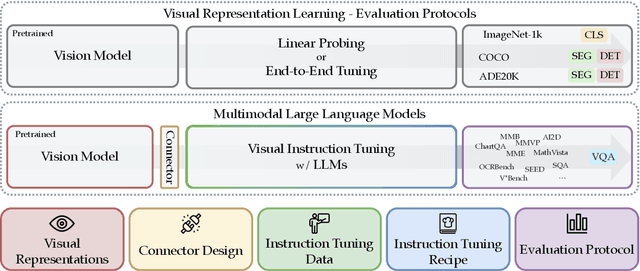



Abstract:We introduce Cambrian-1, a family of multimodal LLMs (MLLMs) designed with a vision-centric approach. While stronger language models can enhance multimodal capabilities, the design choices for vision components are often insufficiently explored and disconnected from visual representation learning research. This gap hinders accurate sensory grounding in real-world scenarios. Our study uses LLMs and visual instruction tuning as an interface to evaluate various visual representations, offering new insights into different models and architectures -- self-supervised, strongly supervised, or combinations thereof -- based on experiments with over 20 vision encoders. We critically examine existing MLLM benchmarks, addressing the difficulties involved in consolidating and interpreting results from various tasks, and introduce a new vision-centric benchmark, CV-Bench. To further improve visual grounding, we propose the Spatial Vision Aggregator (SVA), a dynamic and spatially-aware connector that integrates high-resolution vision features with LLMs while reducing the number of tokens. Additionally, we discuss the curation of high-quality visual instruction-tuning data from publicly available sources, emphasizing the importance of data source balancing and distribution ratio. Collectively, Cambrian-1 not only achieves state-of-the-art performance but also serves as a comprehensive, open cookbook for instruction-tuned MLLMs. We provide model weights, code, supporting tools, datasets, and detailed instruction-tuning and evaluation recipes. We hope our release will inspire and accelerate advancements in multimodal systems and visual representation learning.
Qwen Technical Report
Sep 28, 2023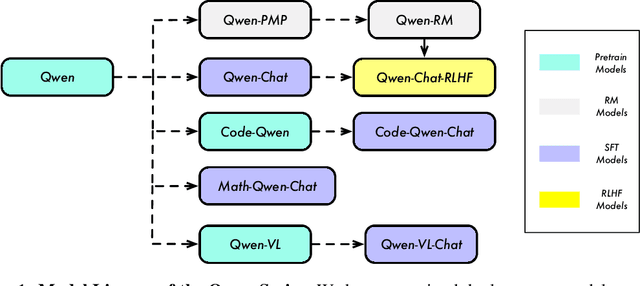

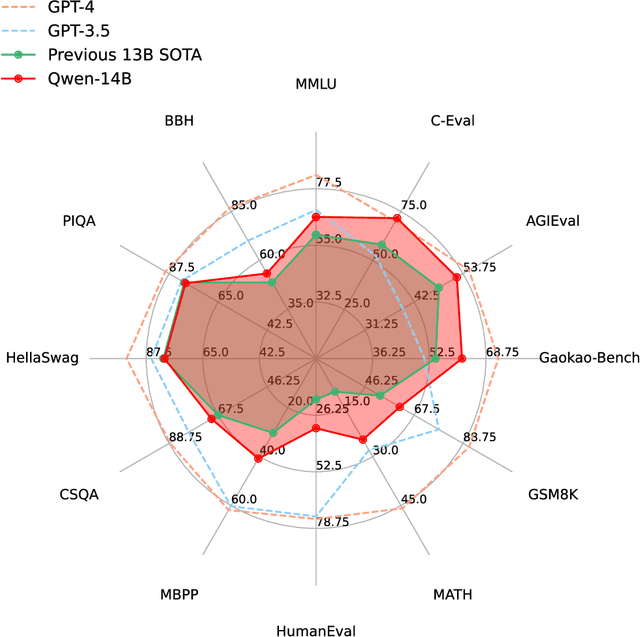
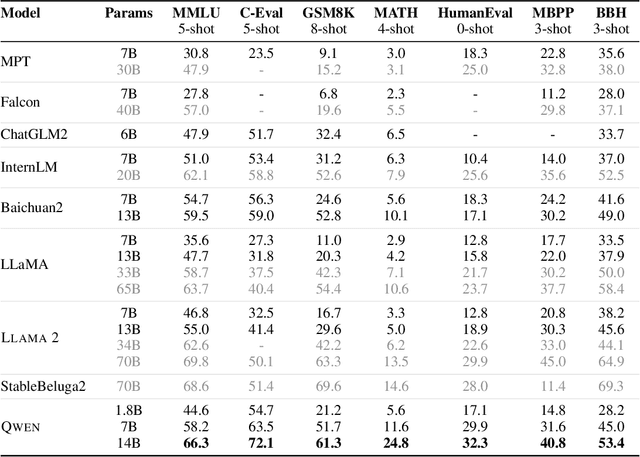
Abstract:Large language models (LLMs) have revolutionized the field of artificial intelligence, enabling natural language processing tasks that were previously thought to be exclusive to humans. In this work, we introduce Qwen, the first installment of our large language model series. Qwen is a comprehensive language model series that encompasses distinct models with varying parameter counts. It includes Qwen, the base pretrained language models, and Qwen-Chat, the chat models finetuned with human alignment techniques. The base language models consistently demonstrate superior performance across a multitude of downstream tasks, and the chat models, particularly those trained using Reinforcement Learning from Human Feedback (RLHF), are highly competitive. The chat models possess advanced tool-use and planning capabilities for creating agent applications, showcasing impressive performance even when compared to bigger models on complex tasks like utilizing a code interpreter. Furthermore, we have developed coding-specialized models, Code-Qwen and Code-Qwen-Chat, as well as mathematics-focused models, Math-Qwen-Chat, which are built upon base language models. These models demonstrate significantly improved performance in comparison with open-source models, and slightly fall behind the proprietary models.
Qwen-VL: A Versatile Vision-Language Model for Understanding, Localization, Text Reading, and Beyond
Sep 14, 2023Abstract:We introduce the Qwen-VL series, a set of large-scale vision-language models (LVLMs) designed to perceive and understand both text and images. Comprising Qwen-VL and Qwen-VL-Chat, these models exhibit remarkable performance in tasks like image captioning, question answering, visual localization, and flexible interaction. The evaluation covers a wide range of tasks including zero-shot captioning, visual or document visual question answering, and grounding. We demonstrate the Qwen-VL outperforms existing LVLMs. We present their architecture, training, capabilities, and performance, highlighting their contributions to advancing multimodal artificial intelligence. Code, demo and models are available at https://github.com/QwenLM/Qwen-VL.
TouchStone: Evaluating Vision-Language Models by Language Models
Sep 04, 2023Abstract:Large vision-language models (LVLMs) have recently witnessed rapid advancements, exhibiting a remarkable capacity for perceiving, understanding, and processing visual information by connecting visual receptor with large language models (LLMs). However, current assessments mainly focus on recognizing and reasoning abilities, lacking direct evaluation of conversational skills and neglecting visual storytelling abilities. In this paper, we propose an evaluation method that uses strong LLMs as judges to comprehensively evaluate the various abilities of LVLMs. Firstly, we construct a comprehensive visual dialogue dataset TouchStone, consisting of open-world images and questions, covering five major categories of abilities and 27 subtasks. This dataset not only covers fundamental recognition and comprehension but also extends to literary creation. Secondly, by integrating detailed image annotations we effectively transform the multimodal input content into a form understandable by LLMs. This enables us to employ advanced LLMs for directly evaluating the quality of the multimodal dialogue without requiring human intervention. Through validation, we demonstrate that powerful LVLMs, such as GPT-4, can effectively score dialogue quality by leveraging their textual capabilities alone, aligning with human preferences. We hope our work can serve as a touchstone for LVLMs' evaluation and pave the way for building stronger LVLMs. The evaluation code is available at https://github.com/OFA-Sys/TouchStone.
ViTMatte: Boosting Image Matting with Pretrained Plain Vision Transformers
May 24, 2023Abstract:Recently, plain vision Transformers (ViTs) have shown impressive performance on various computer vision tasks, thanks to their strong modeling capacity and large-scale pretraining. However, they have not yet conquered the problem of image matting. We hypothesize that image matting could also be boosted by ViTs and present a new efficient and robust ViT-based matting system, named ViTMatte. Our method utilizes (i) a hybrid attention mechanism combined with a convolution neck to help ViTs achieve an excellent performance-computation trade-off in matting tasks. (ii) Additionally, we introduce the detail capture module, which just consists of simple lightweight convolutions to complement the detailed information required by matting. To the best of our knowledge, ViTMatte is the first work to unleash the potential of ViT on image matting with concise adaptation. It inherits many superior properties from ViT to matting, including various pretraining strategies, concise architecture design, and flexible inference strategies. We evaluate ViTMatte on Composition-1k and Distinctions-646, the most commonly used benchmark for image matting, our method achieves state-of-the-art performance and outperforms prior matting works by a large margin.
MobileInst: Video Instance Segmentation on the Mobile
Mar 30, 2023Abstract:Although recent approaches aiming for video instance segmentation have achieved promising results, it is still difficult to employ those approaches for real-world applications on mobile devices, which mainly suffer from (1) heavy computation and memory cost and (2) complicated heuristics for tracking objects. To address those issues, we present MobileInst, a lightweight and mobile-friendly framework for video instance segmentation on mobile devices. Firstly, MobileInst adopts a mobile vision transformer to extract multi-level semantic features and presents an efficient query-based dual-transformer instance decoder for mask kernels and a semantic-enhanced mask decoder to generate instance segmentation per frame. Secondly, MobileInst exploits simple yet effective kernel reuse and kernel association to track objects for video instance segmentation. Further, we propose temporal query passing to enhance the tracking ability for kernels. We conduct experiments on COCO and YouTube-VIS datasets to demonstrate the superiority of MobileInst and evaluate the inference latency on a mobile CPU core of Qualcomm Snapdragon-778G, without other methods of acceleration. On the COCO dataset, MobileInst achieves 30.5 mask AP and 176 ms on the mobile CPU, which reduces the latency by 50% compared to the previous SOTA. For video instance segmentation, MobileInst achieves 35.0 AP on YouTube-VIS 2019 and 30.1 AP on YouTube-VIS 2021. Code will be available to facilitate real-world applications and future research.
Masked Visual Reconstruction in Language Semantic Space
Jan 17, 2023Abstract:Both masked image modeling (MIM) and natural language supervision have facilitated the progress of transferable visual pre-training. In this work, we seek the synergy between two paradigms and study the emerging properties when MIM meets natural language supervision. To this end, we present a novel masked visual Reconstruction In Language semantic Space (RILS) pre-training framework, in which sentence representations, encoded by the text encoder, serve as prototypes to transform the vision-only signals into patch-sentence probabilities as semantically meaningful MIM reconstruction targets. The vision models can therefore capture useful components with structured information by predicting proper semantic of masked tokens. Better visual representations could, in turn, improve the text encoder via the image-text alignment objective, which is essential for the effective MIM target transformation. Extensive experimental results demonstrate that our method not only enjoys the best of previous MIM and CLIP but also achieves further improvements on various tasks due to their mutual benefits. RILS exhibits advanced transferability on downstream classification, detection, and segmentation, especially for low-shot regimes. Code will be made available at https://github.com/hustvl/RILS.
Masked Image Modeling with Denoising Contrast
May 19, 2022
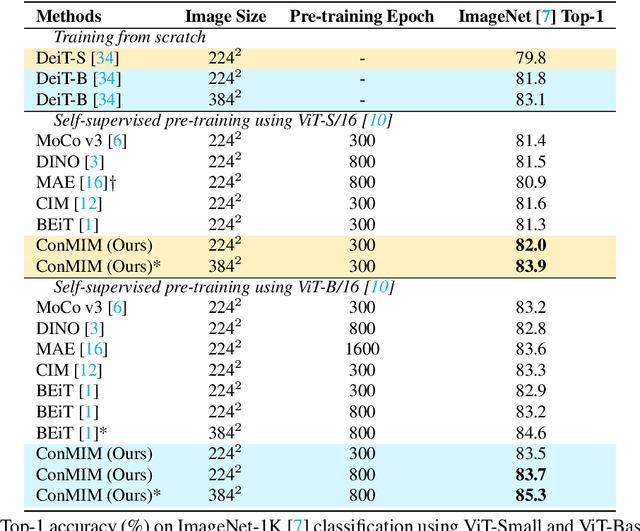
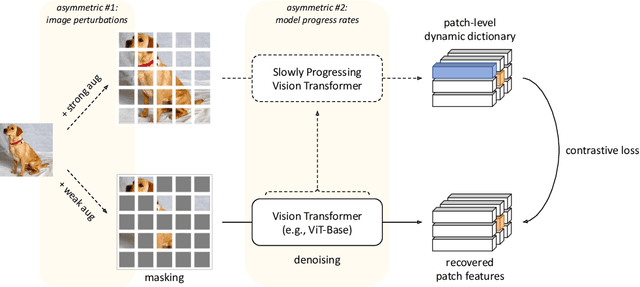
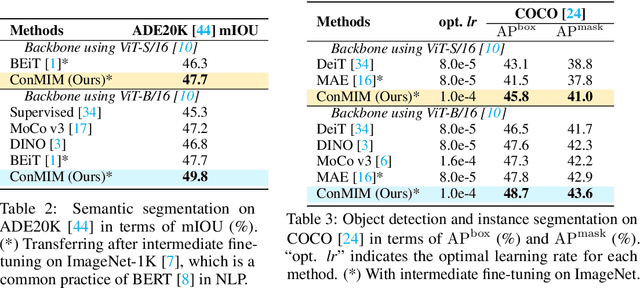
Abstract:Since the development of self-supervised visual representation learning from contrastive learning to masked image modeling, there is no significant difference in essence, that is, how to design proper pretext tasks for vision dictionary look-up. Masked image modeling recently dominates this line of research with state-of-the-art performance on vision Transformers, where the core is to enhance the patch-level visual context capturing of the network via denoising auto-encoding mechanism. Rather than tailoring image tokenizers with extra training stages as in previous works, we unleash the great potential of contrastive learning on denoising auto-encoding and introduce a new pre-training method, ConMIM, to produce simple intra-image inter-patch contrastive constraints as the learning objectives for masked patch prediction. We further strengthen the denoising mechanism with asymmetric designs, including image perturbations and model progress rates, to improve the network pre-training. ConMIM-pretrained vision Transformers with various scales achieve promising results on downstream image classification, semantic segmentation, object detection, and instance segmentation tasks.
 Add to Chrome
Add to Chrome Add to Firefox
Add to Firefox Add to Edge
Add to Edge